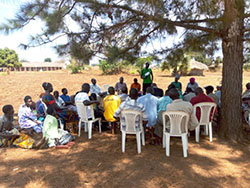An exit strategy was inherent in the N2Africa project design to allow successful grain legume technologies at scale but also have a strategy for a pipeline of technologies to be continuously evaluated and availed to the farmers to improve their production systems and welfare. The quest for such a strategy was a major focus of the project for Uganda in the last year of the project
N2Africa project has used different approaches with partners to disseminate grain legume technologies including demonstrations, farmer try-outs and use of media. To meet the aspirations of an exit strategy, and ICT based approach was considered as because of possible fast response, being cheap and limited in reach to only the project action sites. In partnership with Agricultural information Systems Brokerage Association (AGINSBA), remodelling of the m-Omulimisa (https://m-omulimisa.com/) from a platform for only extension support to a platform that encompasses grain legume technologies dissemination, brokerage services on inputs and output markets.
The changes or modifications
To this end ICT services including mobile telephony using SMS services were included. Whereas it is true that mobile telephone penetration in the country has increased over the years, the use of mobile telephones by segments of smallholder farmers is limited to making and receiving calls. There was a need to address that barrier in the use of mobile telephones to access agricultural information in general. The human dimension to the virtual platform with specific focus of helping farmers was strengthened and the platform rebranded by integrating village agents to a knowledge and information village agent model. The village agents play a key role in supporting farmers and farmer associations with aggregation of demand for inputs and also output which they then share through the platform with potential buyers. The village agents also play roles of; profiling farmers and farmer groups, supporting set up of demonstrations, providing technical advisory support (resident memory) for the farming communities, and networking with input and output traders with the outside localities of farming communities. Agro-dealers are included in the systems and are linked with farmer associations and as well as well-known or established buyers of grain legumes buyers.
What has happened
The KIVA model of m-Omulimisa has been piloted in the northern region of the country in the Lango and Acholi sub-regions with good success. Thirty (30) village agents were trained, and they have been able to profile 556 farmers groups totalling to over 17,297 farmers and these have been researched used a bundled services including crop insurance cover, access to finance, access to quality inputs and linkages to buyers.
 |
Left: Village agent, Mr Odyek (checked shirt 2nd left from group leader in green), meeting a farmers group in Apac to collect information on inputs needed Right: A group assessment meeting by IIRR and Microfinance Uganda services limited for accessing financial loan in Pader, Northern Uganda |
 |
Through this platform, several new partnerships have been created including the International Institute of Rural reconstruction, Uganda Microfinance Services and these have continued to advance the technologies by looking at critical areas such as financial access which led to support of at least 15 groups so far with loans for inputs totalling to 120 Million Uganda Shillings (equivalent to 32432 USD). Many partners are getting hooked to the platform including MAAIF and definitely beginning with new demands and slowly growing the platform to embrace a systems wide approach with time but also taking a national coverage. Dissemination of technologies is done through SMS and this is sent to as many farmers in the platform and this could contribute to creating demand for the technologies. The piloting of the m-Omulimisa platform has contributed to increased reach of the project and now standing at cumulative total of over 83,111 farmers. This arrangement is so far working well for inputs for soyabean, maize and sunflower producers in the northern region depicting a proliferation into a systems perspective. This already helped in estimating input demands for the 2019, albeit useful for tackling the fractured demand problems. The platform provides a prospect through the private sector coordination to keep the relevant N2Africa activities on-going, particularly access to input and output markets and as knowledge and information support for dissemination of the technologies and in its nature useful approach for large scale dissemination.
For the full 2018 annual report for Uganda in which this exit strategy is referred to, click here.
By Peter Ebanyat, N2Africa country coordinator Uganda and Daniel Ninsiima, Founder and Managing Director at m-Omulimisa
